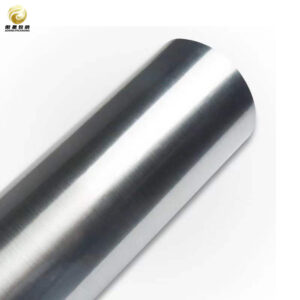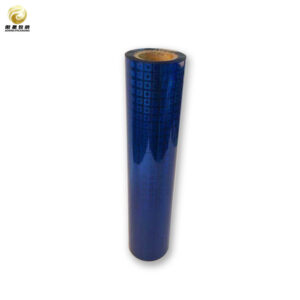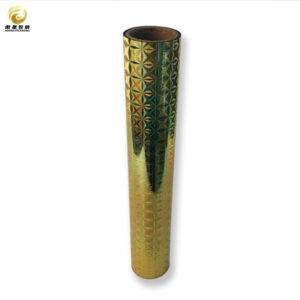Translucent PET Film
| Product | Transparent PET Film |
| Material | PET + color+ aluminum layer / PET + aluminum + color layer |
| Thickness | 12~188um |
| Color Option | Red,Blue,Purple,Green,Gold,Yellow,Rose,Rainbow,etc. |
| Width & Length | Width:500~1800mm Length:Customized |
Detailed Descriptions
Translucent PET film, also known as polyethylene terephthalate film, is a versatile material that has gained significant importance in various industries. It is a type of plastic film that offers a unique combination of transparency and translucency, making it suitable for a wide range of applications. Translucent PET film is known for its durability, chemical resistance, heat resistance, and electrical insulation properties. Its ability to transmit light while diffusing it makes it an ideal choice for packaging, electrical and electronics, medical, automotive, and construction industries.
Properties and Characteristics of Translucent PET Film
Transparency and translucency are key properties of translucent PET film. It allows light to pass through while diffusing it, creating a soft and diffused glow. This property makes it ideal for applications where controlled lighting is required, such as in packaging or signage.
Durability and strength are other important characteristics of translucent PET film. It is highly resistant to tearing and puncturing, making it suitable for applications that require a strong and durable material. Additionally, it has excellent chemical resistance, making it resistant to many solvents and chemicals commonly used in various industries.
Translucent PET film also exhibits excellent heat resistance, allowing it to withstand high temperatures without deforming or melting. This property makes it suitable for applications that involve exposure to heat or thermal processes.
Furthermore, translucent PET film offers excellent electrical insulation properties. It has low electrical conductivity, making it an ideal choice for applications that require electrical insulation, such as in the electrical and electronics industry.
Applications of Translucent PET Film
The versatility of translucent PET film makes it widely used in various industries. In the packaging industry, it is commonly used for food packaging, labels, and sleeves. Its transparency allows consumers to see the product inside while its translucency diffuses light to create an attractive visual effect.
In the electrical and electronics industry, translucent PET film is used for insulation in cables and wires. Its electrical insulation properties make it an ideal choice for this application. It is also used for display screens, touch panels, and membrane switches due to its transparency and durability.
In the medical industry, translucent PET film is used for medical packaging, such as blister packs and pouches. Its chemical resistance ensures that the packaging remains intact and protects the contents from contamination. It is also used for medical devices and equipment due to its durability and heat resistance.
The automotive industry utilizes translucent PET film for various applications, including interior trim, instrument panels, and lighting. Its ability to transmit light while diffusing it allows for creative lighting designs in vehicles.
In the construction industry, translucent PET film is used for architectural glazing, roofing, and skylights. Its transparency allows natural light to enter the building while its heat resistance ensures that it can withstand outdoor conditions.
Advantages of Translucent PET Film over Other Materials
| Advantages of Translucent PET Film over Other Materials |
|---|
| 1. High Clarity |
| 2. Excellent Printability |
| 3. Good Chemical Resistance |
| 4. Lightweight |
| 5. Cost-Effective |
| 6. Recyclable |
| 7. Versatile |
One of the key advantages of translucent PET film is its lightweight and flexible nature. It is much lighter than glass or metal, making it easier to handle and transport. Its flexibility allows it to be easily molded into different shapes and sizes, making it highly versatile.
Cost-effectiveness is another advantage of translucent PET film. It is generally more affordable than other materials such as glass or metal. Additionally, its durability ensures a longer lifespan, reducing the need for frequent replacements.
Translucent PET film is also recyclable and eco-friendly. It can be recycled into new products or used as a raw material for other applications. This reduces waste and contributes to a more sustainable environment.
Furthermore, translucent PET film offers versatility and customization options. It can be produced in different finishes, such as matte or glossy, to suit specific requirements. It can also be colored or made UV-resistant to meet different application needs.
Manufacturing Process of Translucent PET Film
Translucent PET film is manufactured through various processes, including extrusion, coating, and lamination.
The extrusion process involves melting the PET resin and passing it through a die to form a continuous sheet. The sheet is then cooled and solidified to form the translucent PET film. This process allows for the production of large quantities of film with consistent thickness and quality.
The coating process involves applying a thin layer of coating material onto the surface of the PET film. This can enhance its properties, such as improving its chemical resistance or adding a glossy finish. The coated film is then dried and cured to ensure adhesion and durability.
The lamination process involves bonding multiple layers of PET film together to create a thicker and more durable material. This process is commonly used in applications that require increased strength or barrier properties.
Types of Translucent PET Film
Translucent PET film is available in different types, each offering unique characteristics and finishes.
Matte finish translucent PET film has a non-reflective surface that diffuses light evenly. It is commonly used in applications where glare needs to be minimized, such as in displays or lighting fixtures.
Glossy finish translucent PET film has a smooth and reflective surface that enhances the appearance of the material. It is often used in applications where a high-quality finish is desired, such as in packaging or signage.
Colored finish translucent PET film is available in a wide range of colors, allowing for customization and branding opportunities. It can be used to create visually appealing packaging or to match specific design requirements.
UV-resistant finish translucent PET film is designed to withstand exposure to ultraviolet (UV) radiation without degrading or discoloring. It is commonly used in outdoor applications where protection against UV radiation is necessary, such as in architectural glazing or automotive lighting.
Comparison of Translucent PET Film with Other PET Films
Clear PET film, also known as transparent PET film, is similar to translucent PET film in terms of its transparency. However, clear PET film does not diffuse light like translucent PET film does. It is commonly used in applications where complete transparency is required, such as in windows or display screens.
Metallized PET film, on the other hand, has a thin layer of metal deposited onto its surface. This gives it a reflective and metallic appearance. It is often used in applications where a decorative or reflective finish is desired, such as in packaging or labels.
White PET film is opaque and does not allow light to pass through. It is commonly used in applications where opacity is required, such as in labels or cards. Unlike translucent PET film, white PET film does not offer the same light diffusion properties.
Environmental Impact of Translucent PET Film
Translucent PET film has a relatively low environmental impact compared to other materials. It is highly recyclable and can be processed into new products or used as a raw material for other applications. This reduces the amount of waste generated and conserves resources.
The carbon footprint of translucent PET film is also relatively low compared to other materials. Its lightweight nature reduces transportation emissions, and its durability ensures a longer lifespan, reducing the need for frequent replacements.
While translucent PET film is not biodegradable, its recyclability and reusability contribute to a more sustainable environment. Proper recycling and waste management practices are essential to ensure that the material is effectively recycled and does not end up in landfills or oceans.
Maintenance and Care of Translucent PET Film
To maintain the quality and appearance of translucent PET film, proper cleaning and care are necessary. Cleaning should be done using mild soap or detergent and warm water. Abrasive cleaners or solvents should be avoided as they can damage the film.
Storage and handling of translucent PET film should be done in a clean and dry environment to prevent contamination or damage. It should be stored away from direct sunlight or heat sources to avoid deformation or discoloration.
Translucent PET film should be protected from prolonged exposure to UV radiation, as it can cause degradation or discoloration over time. UV-resistant finishes can provide additional protection against UV radiation and extend the lifespan of the film.
Future of Translucent PET Film in the Industry
The future of translucent PET film in the industry looks promising, with emerging trends and innovations driving its growth. The demand for sustainable packaging solutions is increasing, and translucent PET film offers a recyclable and eco-friendly alternative to traditional materials.
Advancements in technology are also expanding the applications of translucent PET film. For example, the development of flexible electronics and wearable devices requires materials that are lightweight, durable, and transparent. Translucent PET film meets these requirements and is expected to play a significant role in these emerging industries.
The market for translucent PET film is projected to grow steadily in the coming years, driven by the increasing demand from various industries. As businesses and consumers become more aware of the benefits of translucent PET film, its adoption is expected to increase, further driving market growth.
Conclusion and Final Thoughts on Translucent PET Film
In conclusion, translucent PET film is a versatile material that offers a unique combination of transparency and translucency. Its properties and characteristics make it suitable for a wide range of applications in various industries. Its advantages over other materials, such as its lightweight nature, cost-effectiveness, recyclability, and versatility, make it an attractive choice for businesses and consumers.
The manufacturing process of translucent PET film involves extrusion, coating, and lamination. Different types of translucent PET film are available, including matte finish, glossy finish, colored finish, and UV-resistant finish. It can be compared to other PET films such as clear PET film, metallized PET film, and white PET film.
The environmental impact of translucent PET film is relatively low, thanks to its recyclability and low carbon footprint. Proper maintenance and care are necessary to ensure the longevity and appearance of translucent PET film.
The future of translucent PET film in the industry looks promising, with emerging trends and innovations driving its growth. The market for translucent PET film is expected to grow steadily, driven by the increasing demand from various industries. As businesses and consumers continue to recognize the benefits of translucent PET film, its adoption is likely to increase, further fueling its market growth.
FAQs
What is Translucent PET Film?
Translucent PET Film is a type of plastic film made from polyethylene terephthalate (PET) that allows light to pass through it while diffusing it. It is commonly used in packaging, printing, and labeling applications.
What are the benefits of using Translucent PET Film?
Translucent PET Film offers several benefits, including high clarity, excellent printability, good dimensional stability, and resistance to moisture, chemicals, and abrasion. It is also lightweight, flexible, and recyclable.
What are the applications of Translucent PET Film?
Translucent PET Film is used in a wide range of applications, including food and beverage packaging, medical packaging, labels and decals, window films, and graphic arts. It is also used in the production of solar cells, electronic displays, and other high-tech products.
What are the different types of Translucent PET Film?
There are several types of Translucent PET Film available, including clear, matte, and colored films. Clear films offer high clarity and transparency, while matte films provide a frosted or diffused appearance. Colored films are available in a range of colors and tints.
How is Translucent PET Film produced?
Translucent PET Film is produced by extruding PET resin through a flat die and then stretching it in both the machine and transverse directions. This process aligns the polymer chains and orients the molecules, resulting in a film with high clarity and strength.
Is Translucent PET Film recyclable?
Yes, Translucent PET Film is recyclable and can be recycled through the same channels as other PET products. It is important to check with local recycling facilities to ensure that they accept PET film.
#!trpst#trp-gettext data-trpgettextoriginal=1975#!trpen#Productos relacionados#!trpst#/trp-gettext#!trpen#
-

#!trpst#trp-gettext data-trpgettextoriginal=1247#!trpen#Leer más#!trpst#/trp-gettext#!trpen#Brushed Surface PET Film -

#!trpst#trp-gettext data-trpgettextoriginal=1247#!trpen#Leer más#!trpst#/trp-gettext#!trpen#Holographic Polyester Film -

#!trpst#trp-gettext data-trpgettextoriginal=1247#!trpen#Leer más#!trpst#/trp-gettext#!trpen#Holographic Lamination Film -

#!trpst#trp-gettext data-trpgettextoriginal=1247#!trpen#Leer más#!trpst#/trp-gettext#!trpen#Clear Polyester Film



